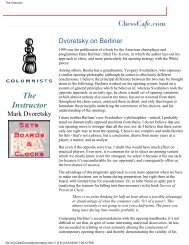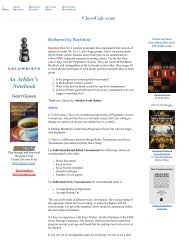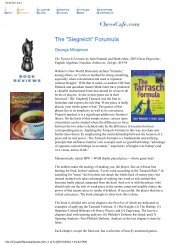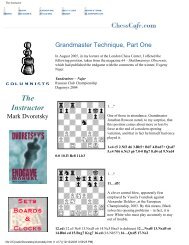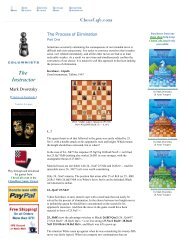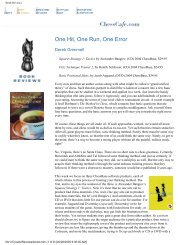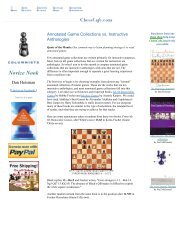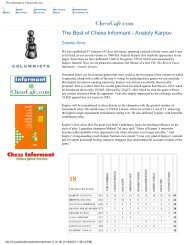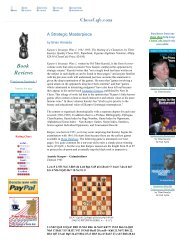Back to Basics: Strategy - Chess Cafe
Back to Basics: Strategy - Chess Cafe
Back to Basics: Strategy - Chess Cafe
You also want an ePaper? Increase the reach of your titles
YUMPU automatically turns print PDFs into web optimized ePapers that Google loves.
Book<br />
Reviews<br />
Translate this page<br />
Rating Chart<br />
Awful –<br />
Poor –<br />
Uneven –<br />
Good –<br />
Great –<br />
Excellent –<br />
Paring <strong>Chess</strong> <strong>to</strong> its Essence<br />
by John D. Warth<br />
<strong>Back</strong> <strong>to</strong> <strong>Basics</strong>: <strong>Strategy</strong> by Valeri Beim, Russell Enterprises 2011,<br />
Paperback, Figurine Algebraic Notation, 224pp. $22.95 (<strong>Chess</strong><strong>Cafe</strong> Price:<br />
$18.95)<br />
It is a good thing I was taught not <strong>to</strong> judge a book by its cover; otherwise, I<br />
would have passed over this gem by Viennese international master Valeri<br />
Beim. The confusing cover art depicts a chess queen, her open midsection<br />
with exposed pendulum clockworks, and an explosion of letters and numerals<br />
in a confetti of colors and sizes. What the artist had in mind, I will leave <strong>to</strong><br />
our astute readership <strong>to</strong> interpret.<br />
This volume of the <strong>Back</strong> <strong>to</strong> <strong>Basics</strong> series targets intermediate club and<br />
<strong>to</strong>urnament players who might want a more solid grounding in strategic<br />
principles and chess fundamentals. More advanced players will be familiar<br />
with these important concepts, but the author has interposed a myriad of<br />
interesting illustrative games that anyone can learn from and enjoy.<br />
Unlike other writers, Beim doesn't make the mistake of assuming <strong>to</strong>o much<br />
about what his readers might already know. In explaining the basics, the<br />
author has a knack for paring chess <strong>to</strong> its essence. The author shows us, both<br />
in words and with copious diagrams, how <strong>to</strong> evaluate positions. Only then can<br />
we proceed with a plan.<br />
The author has divided his treatise <strong>to</strong>pically, with subjects including piece<br />
development, control of central squares, exploiting two distanced weaknesses,<br />
principle effects of pawn structures, piece coordination, the strengths of<br />
bishop-pairs, when <strong>to</strong> implement plans, and the strengths and effects of<br />
controlling open lines. However, no index is provided for themes or games.<br />
Beim's approach reminds me of another great instruc<strong>to</strong>r, Australian and world<br />
correspondence champion and author, Cecil Purdy. Like Purdy, Beim's<br />
strength is clarity, as in this example, from Chapter Three, "The Center":<br />
Kramnik – Kasparov, Novogrod 1997<br />
[FEN "5r2/1p3q1k/r2p3p/1NpPb3/P1n1Pp2/<br />
5R1Q/5P1P/2B3RK"]<br />
"What strikes you first? That both the center squares which are<br />
unoccupied by pawns are securely controlled by black pieces, and that<br />
White's heavy pieces are concentrated on the kingside, where the open gfile<br />
is so attractive – but here his minor pieces stand, temporarily far<br />
removed from that side of the board. And of course, the weaknesses:<br />
White's pawn at a4 is doomed; its demise will open a path for Black's<br />
Lessons in <strong>Chess</strong> <strong>Strategy</strong><br />
by Valeri Beim<br />
<strong>Chess</strong> <strong>Strategy</strong> for<br />
Club Players<br />
by Herman Grooten<br />
Soviet <strong>Chess</strong> <strong>Strategy</strong><br />
by Alexei Suetin
ook in<strong>to</strong> the enemy camp. White, for his part, intends <strong>to</strong> remove the f4pawn,<br />
although this will not be so easy."<br />
For less experienced players, Beim's principled approach might seem more<br />
lucid than those aimed at more advanced players. Books with less text and<br />
more lines of analysis can be confusing and tiresome, even for experts.<br />
Instructively, Beim reminds us that tactics without strategic goals are of little<br />
use.<br />
Beim emphasizes the over-arching importance of pawn structure on strategy.<br />
Pawns, he says, are the slowest and most critical aspect of positional change.<br />
Their moves can create permanent weaknesses, and mistakes in pawn<br />
structure are costly and often unfixable. Pawns alone move without looking<br />
back and so must advance with caution.<br />
Positional weaknesses are the <strong>to</strong>pic of Chapter Five, where Beim includes the<br />
game Smyslov – Simagin, played at Moscow in 1955 <strong>to</strong> illustrate<br />
evaluational specifics:<br />
[FEN "8/2n2rkp/4p1p1/p1N3P1/1pP2P2/<br />
4PK2/P7/3R4"]<br />
"At a glance, it is obvious that White has the advantage in this position.<br />
It can be measured four ways: (a) his control of the only open file; (b)<br />
his more active king; (c) his more active knight; and (d) his more active<br />
pawn configuration on the kingside. The number of isolated pawns even<br />
favors Black: he has one, White has two. As Smyslov convincingly<br />
demonstrates, only White can reap any benefit from the opponent's<br />
isolated pawns. The reason is simple: he has something he can do with<br />
it, while his opponent has nothing! The difference in activity of all the<br />
elements of the position, without exception, between the two sides<br />
explains why this should be so. The game continued..."<br />
37.Ke4 h6 38.Rd6! hxg5 39.fxg5<br />
"Now all four of White's pawns are isolated, but Black gains very little<br />
from it, for the reason already cited. Meanwhile, White's pieces forge<br />
irresistibly ahead, invading the enemy's position."<br />
39...Kf8 40.Rc6 Ke8 41.Ke5!<br />
"A very useful moment for anyone who wants <strong>to</strong> learn the technique of<br />
realizing an advantage. White could have won a pawn; but after 41.<br />
Nxe6 Re7 42.Rxc7 (how terrible it would have been <strong>to</strong> lose this game,<br />
which is what would happen after 42.Ke5?? a4 43.Kf6 Rxe6+ 44.Rxe6+<br />
Nxe6 45.Kxe6 b3) 42...Rxe6+, Black would gain definite counterplay –<br />
better than he had up till now. And an important element in good<br />
technique of realizing an advantage is just this: knowing how <strong>to</strong> keep<br />
one's opponent from gaining more counterplay than he deserves from<br />
his previous play! So Smyslov refuses <strong>to</strong> take the pawn, choosing<br />
instead <strong>to</strong> strengthen the position of his pieces still further."<br />
General readers will enjoy the play-by-play analysis of this book, along with<br />
its ample diagrams. (Many page spreads have four <strong>to</strong> seven diagrams!) More<br />
advanced players will enjoy the many astutely-chosen games that illustrate<br />
selected strategies and plans. It is unfortunate that so few guidebooks can do
this. Even computer databases, for all their limitless strengths, crunch just lists<br />
of moves: it is usually left up <strong>to</strong> the user <strong>to</strong> sort, digest, and apply all the data.<br />
Anyone who has ever watched the playing engine Fritz calculate moves at<br />
light-speed has probably experienced this kind of analytical frustration.<br />
Principles of chess are best unders<strong>to</strong>od when explained both verbally and<br />
visually. Books take a person-<strong>to</strong>-person approach, especially so in the hands<br />
of a caring teacher. Databases have their place, of course, and I would be a<br />
less effective instruc<strong>to</strong>r and player without my own, but it is heartening that<br />
good writers are still out there and able <strong>to</strong> sort, analyze, and interpret this<br />
wonderful but incorrigibly frustrating game. This is a good, but not groundbreaking<br />
book hidden beneath a terrible and confusing cover.<br />
My assessment of this product:<br />
Order <strong>Back</strong> <strong>to</strong> <strong>Basics</strong>: <strong>Strategy</strong><br />
by Valeri Beim<br />
A PDF file of this week's review, along with all previous product reviews, is<br />
available in the <strong>Chess</strong><strong>Cafe</strong>.com Archives.<br />
Comment on this week's column via our Contact Page! Pertinent responses<br />
will be posted below daily.<br />
[<strong>Chess</strong><strong>Cafe</strong> Home Page] [Book Review] [Columnists]<br />
[Endgame Study] [The Skittles Room] [<strong>Chess</strong><strong>Cafe</strong> Archives]<br />
[<strong>Chess</strong><strong>Cafe</strong> Links] [Online Books<strong>to</strong>re] [About <strong>Chess</strong><strong>Cafe</strong>.com]<br />
[Contact <strong>Chess</strong><strong>Cafe</strong>.com] [Advertising]<br />
© 2012 BrainGamz, Inc. All Rights Reserved.<br />
"<strong>Chess</strong><strong>Cafe</strong>.com®" is a registered trademark of BrainGamz, Inc.



